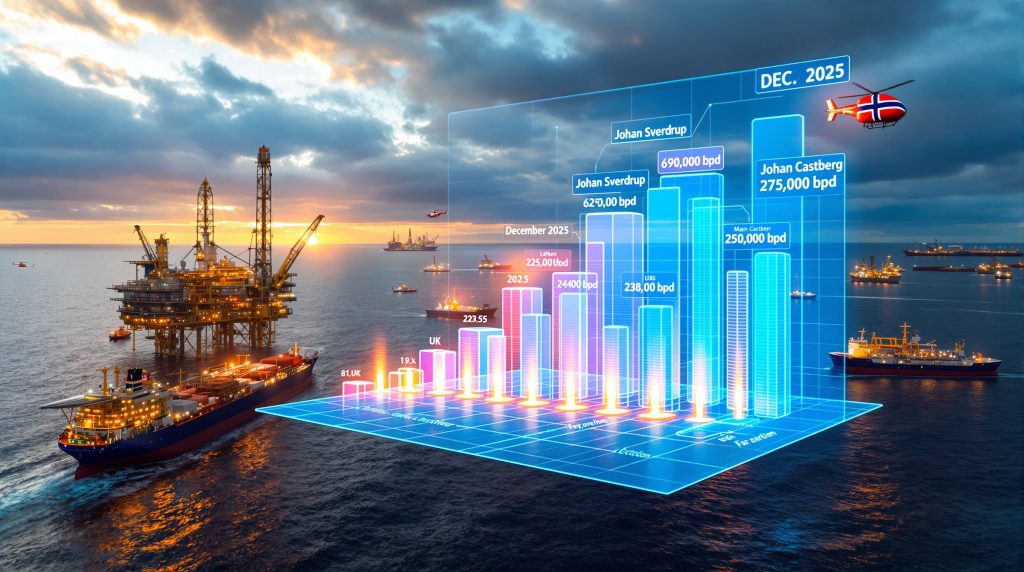Understanding North Sea Crude Export Operations
North Sea oil loadings represent a sophisticated system of crude oil export scheduling and transportation that connects offshore production facilities with global markets. These loading programs serve as the backbone for coordinating the movement of petroleum from remote platforms and floating production units to refineries worldwide. Furthermore, understanding the intricacies of these operations requires analysing current oil price rally analysis to grasp market dynamics.
The geographic scope encompasses both the Norwegian Continental Shelf and UK sectors, creating a complex network of production assets that collectively influence international oil pricing mechanisms. According to Bloomberg Energy analysis, the region's strategic position allows it to serve as a critical supply hub for European and Atlantic Basin markets.
Loading programs function through detailed monthly scheduling systems that coordinate between field operators, pipeline companies, and shipping organisations. These schedules must account for production forecasts, maintenance windows, weather patterns, and market demand fluctuations to optimise cargo delivery timing.
The Strategic Importance of North Sea Crude Grades
The BFOET benchmark composition consisting of Brent, Forties, Oseberg, Ekofisk, and Troll crude grades forms the foundation of global oil pricing through its connection to Dated Brent assessments. This benchmark system, managed by Platts and other price reporting agencies, establishes reference prices for crude oil contracts worldwide.
These North Sea crude grades possess specific quality characteristics that make them highly desirable in international markets:
• Low sulphur content ranging from 0.1% to 0.4%, classifying them as sweet crudes
• API gravity typically between 35° and 40°, indicating light crude characteristics
• Excellent refining yields for petrol and diesel production
• Strategic geographic positioning for efficient transportation to major consuming regions
The quality specifications enable these crudes to command premium pricing relative to heavier, higher-sulphur alternatives from other global production regions. Energy consulting firm Wood Mackenzie reports that North Sea grades consistently trade at premiums to regional benchmarks due to their superior processing characteristics.
How North Sea Oil Loading Schedules Function
Monthly loading programme development follows a structured timeline that begins approximately 45-60 days before the actual loading month. Field operators submit preliminary cargo nominations based on production forecasts and maintenance schedules to pipeline operators and terminal facilities.
The coordination process involves multiple stakeholders working together to optimise cargo scheduling:
- Production planning by field operators based on reservoir performance
- Pipeline capacity allocation by transportation companies
- Terminal slot booking at loading facilities
- Vessel scheduling by shipping companies and charterers
- Final programme publication typically 30 days before loading month
Weather window considerations play a crucial role in offshore operations, particularly during winter months when North Sea conditions can restrict loading activities. Industry data indicates that weather-related delays affect approximately 15-20% of scheduled loadings during peak storm seasons.
Key Infrastructure Supporting Export Operations
The North Sea export system relies on an extensive network of pipelines, processing facilities, and terminals that have evolved over five decades of development. Major pipeline systems include the Forties Pipeline System, which transports crude from multiple UK fields to the Cruden Bay terminal, and various Norwegian pipeline networks serving terminals at Mongstad, Sture, and other coastal facilities.
Critical Infrastructure Components:
| Infrastructure Type | Key Examples | Capacity (bpd) |
|---|---|---|
| Pipeline Systems | Forties Pipeline System | 700,000 |
| Norwegian Pipeline Network | 1,200,000 | |
| Loading Terminals | Sullom Voe (UK) | 1,400,000 |
| Mongstad (Norway) | 800,000 | |
| FPSO Vessels | Various Fields | 300,000 |
Floating production storage and offloading vessel operations provide flexibility for fields located far from pipeline infrastructure. These vessels can store crude oil for extended periods and transfer cargoes to shuttle tankers during favourable weather conditions.
Record-High North Sea Oil Loadings in December 2025
North Sea oil loadings are projected to reach 2.1 million barrels per day in December 2025, marking the highest level since May 2017 according to loading schedules analysed by Bloomberg Energy. This represents an increase from 2.03 million bpd in November 2025, driven by multiple production and maintenance factors. Additionally, these developments occur against the backdrop of broader global supply considerations affecting WTI and Brent futures.
December 2025 Loading Projections:
| Field/Grade | Daily Loading Rate (bpd) | Monthly Change |
|---|---|---|
| Johan Sverdrup | 690,000 | +7,000 |
| Johan Castberg | 232,000 | New record |
| BFOET Combined | 587,000 | 5-month high |
| Total North Sea | 2,100,000 | 8-year peak |
The production surge stems from several concurrent developments across the region. Norway's Johan Sverdrup field, operated by Equinor, continues to demonstrate exceptional performance with loading rates increasing to 690,000 bpd from 683,000 bpd in November. This field represents one of the largest oil discoveries in the North Sea during the past three decades.
Return of Maintenance-Affected Production
The Buzzard field restart represents a significant factor in the December loading increase. According to Ineos Group Limited, which operates the Forties Pipeline System, Buzzard's contribution to the Forties blend will rise to 16.9% in December from just 6.2% in November following an extended maintenance shutdown that began in early September 2025.
This maintenance completion affects not only total loading volumes but also crude quality characteristics. The Forties blend composition varies significantly based on contributing field production rates, influencing its trading value relative to other North Sea grades.
Scheduled maintenance completions across multiple Norwegian assets have also contributed to the production recovery. The Norwegian Petroleum Directorate coordinates maintenance activities to minimise simultaneous shutdowns, though some overlap inevitably occurs during optimal weather windows.
New Field Contributions to Export Volumes
Johan Castberg represents the most significant new production addition, with December loadings scheduled at a record 232,000 bpd. This field, located in the Barents Sea approximately 100 kilometres north of Hammerfest, achieved first oil in late 2024 and has been ramping up production throughout 2025.
The field utilises a floating production storage and offloading vessel to process crude oil before transfer to shuttle tankers for transportation to market. Equinor reports that the field contains approximately 650 million barrels of recoverable oil equivalent, making it one of Norway's largest developments in recent years.
Integration of newer developments into existing export infrastructure has required significant coordination between operators and transportation companies. Enhanced recovery projects at mature fields have also contributed to the overall production increase, extending economic field life through advanced extraction techniques.
Global Supply Glut Scenario Development
The timing of increased North Sea oil loadings coincides with warnings from the International Energy Agency regarding a potential global oil oversupply situation developing in 2026. IEA analysis suggests that additional production from OPEC+ countries combined with output increases from non-OPEC producers could exceed demand growth projections. Consequently, understanding the OPEC production impact becomes crucial for market participants.
Market fundamentals indicate several concerning trends for oil price stability:
• Slowing demand growth in major consuming economies including China and India
• Increased production capacity coming online from various global regions
• OPEC+ market share considerations affecting production allocation decisions
• Strategic petroleum reserve releases by consuming nations during previous price spikes
The confluence of these factors suggests that additional North Sea crude supplies may enter markets already experiencing supply-demand imbalances, potentially pressuring prices and profit margins across the petroleum value chain. According to World Oil, these loadings are indeed reaching eight-year highs amid growing supply glut concerns.
Market Timing and Price Implications
Seasonal demand patterns typically show decreased consumption during winter months, particularly for transportation fuels, creating additional challenges for crude oil marketing. The December 2025 loading surge occurs during a traditionally weaker demand period, potentially exacerbating oversupply conditions.
Storage capacity constraints in key markets compound the supply abundance concerns. Commercial crude oil inventories in OECD countries have increased steadily throughout 2025, approaching operational capacity limits in some regions according to Joint Organisations Data Initiative statistics.
Market Insight: The combination of record North Sea production with global oversupply concerns has created significant volatility in crude oil price differentials, with some grades trading at discounts not seen since the 2020 demand collapse.
Impact on crude oil price differentials manifests through widening spreads between different quality grades and geographic markers. North Sea crudes may face increased competition from alternative supplies, potentially reducing the premium pricing traditionally commanded by these high-quality grades. For comprehensive insights into potential market corrections, readers should examine oil price crash insights that detail various scenarios.
Historical Context and Trend Analysis
The December 2025 loading projections represent a remarkable recovery from production levels experienced during the past decade. Comparing current levels to the May 2017 peak of approximately 2.1 million bpd demonstrates the cyclical nature of North Sea production and the impact of sustained investment in field development.
Monthly Variation Patterns in 2025:
- January-March: Average 1.85 million bpd due to weather disruptions
- April-May: Rising to 1.95 million bpd with improved conditions
- June: Historic low of 350,000 bpd BFOET due to coordinated maintenance
- July-September: Gradual recovery to 1.75 million bpd
- October-November: Acceleration to 2.0+ million bpd
- December: Projected peak at 2.1 million bpd
The June 2025 maintenance period demonstrates the dramatic impact of coordinated field shutdowns on regional export capacity. BFOET loadings dropped to a 20-year low of 350,000 bpd during planned maintenance at Ekofisk and Eldfisk fields, highlighting the concentration of production in key facilities.
Individual Field Contributions Analysis
Norway's position as the dominant North Sea producer reflects decades of successful exploration and development activities on the Norwegian Continental Shelf. The Johan Sverdrup field exemplifies the scale and efficiency achievable through modern offshore development techniques.
Major Norwegian Production Assets:
• Johan Sverdrup: 690,000 bpd capacity with expansion potential
• Ekofisk Complex: Multiple satellite fields tied into central processing
• Oseberg Area: Hub development supporting numerous discoveries
• Troll Field: Both oil and gas production with flexible operations
Equinor's operational excellence in managing large-scale developments has established industry benchmarks for project execution and production efficiency. The company's integrated approach to field development maximises resource recovery while minimising environmental impact.
UK sector contributions face ongoing challenges from declining overall production trends and regulatory uncertainties. The Forties system, while still significant, represents a mature basin where maintaining production levels requires continuous investment in enhanced recovery techniques.
Impact on Oil Trading and Pricing Mechanisms
Benchmark crude price discovery processes rely heavily on transparent loading programme information to establish daily Dated Brent assessments. Price reporting agencies utilise cargo availability data, loading schedules, and trading activity to determine fair market value for crude oil transactions.
The loading programme transparency supports efficient price formation by providing market participants with advance notice of crude oil availability. This information enables traders to plan purchases, refiners to schedule processing runs, and shipping companies to optimise vessel deployment.
Trading window implications extend beyond immediate spot market dynamics to influence futures market pricing and long-term contract negotiations. Forward loading schedules provide insights into supply availability that inform hedging strategies and investment decisions across the petroleum value chain. Furthermore, analysis of trade war oil movements reveals additional complexity in pricing mechanisms.
Quality premiums and discounts based on specific crude characteristics fluctuate with refinery demand patterns and processing economics. North Sea crudes typically maintain premiums due to their favourable characteristics, though this advantage may diminish during oversupply periods.
Infrastructure Development Supporting Higher Loading Rates
Pipeline capacity enhancements have played a crucial role in enabling higher North Sea oil loadings. The Forties Pipeline System has undergone multiple optimisation projects to increase throughput capacity and improve operational reliability.
Norwegian pipeline network expansion capabilities continue to support new field developments and production increases from existing assets. The integrated nature of Norway's offshore infrastructure allows efficient tie-in of satellite discoveries to established processing and transportation facilities.
Debottlenecking initiatives at key processing facilities have eliminated constraints that previously limited production rates. These technical improvements, combined with operational excellence programmes, maximise the utilisation of existing infrastructure investments.
Terminal and Storage Infrastructure:
- Sullom Voe Terminal: Capacity utilisation optimisation through scheduling improvements
- Mongstad Complex: Expansion projects supporting increased throughput
- Floating Storage Solutions: Temporary capacity for production flexibility during maintenance periods
Long-Term Production Potential Assessment
Reserve base analysis indicates substantial remaining recoverable resources near existing North Sea infrastructure. The UK Oil and Gas Authority estimates approximately 10-20 billion barrels of recoverable resources remain undeveloped across the UK Continental Shelf, though economic extraction depends on oil prices and technology advances.
Exploration success rates in mature basins have improved significantly through application of advanced seismic imaging and geological modelling techniques. Recent discoveries demonstrate that significant hydrocarbon accumulations remain unidentified despite decades of exploration activity.
Technology advances enabling economic extraction from marginal fields include enhanced oil recovery methods, subsea processing systems, and unmanned platform operations. These innovations extend field economic life and improve recovery factors from existing discoveries. For additional context on North Sea oil development history, readers can explore comprehensive background information.
Energy Transition Impact Considerations
Carbon capture and storage integration with oil operations represents a potential pathway for extending North Sea production while addressing climate change concerns. Several pilot projects are evaluating the technical and economic feasibility of CCS implementation at offshore facilities.
Hydrogen production using existing offshore infrastructure could provide alternative revenue streams for North Sea operators as energy transition accelerates. The extensive pipeline networks and processing facilities offer potential for conversion to hydrogen transport and storage applications.
Decommissioning timelines increasingly influence production planning decisions as fields approach economic limit. The substantial costs associated with platform removal and environmental restoration affect investment decisions and production optimisation strategies.
Investment Climate and Regulatory Environment
UK and Norwegian fiscal policies significantly influence development economics through taxation rates, depletion allowances, and exploration incentives. Recent policy changes in both countries have aimed to balance revenue generation with maintaining investment attractiveness.
Environmental regulations continue evolving to address climate change concerns while supporting continued hydrocarbon production. These regulations affect operational practices, development planning, and long-term strategic planning across the North Sea region.
International market access considerations become increasingly important as global trade patterns evolve and energy security concerns influence government policies. North Sea producers must navigate changing geopolitical dynamics while maintaining competitive market positions.
Supply Chain Adaptation Strategies
Refinery configuration adjustments will become necessary to accommodate increased North Sea crude intake during oversupply periods. Processing facilities may need to optimise operations for specific crude quality characteristics while managing inventory levels effectively.
Transportation and logistics optimisation assumes greater importance as higher volumes move through existing infrastructure systems. Shipping companies must balance vessel deployment between North Sea routes and alternative trading opportunities in other regions.
Storage infrastructure planning requires careful consideration of supply abundance scenarios and their duration. Commercial storage operators may need to expand capacity or modify operations to handle sustained high production levels from North Sea fields.
Market Risk Management Framework
Price volatility mitigation strategies become crucial during periods of supply abundance and uncertain demand growth. Market participants must develop sophisticated hedging approaches that account for crude quality differentials and geographic price spreads.
Contract structure adaptations for oversupply conditions may include flexible loading schedules, quality adjustment mechanisms, and alternative destination clauses. These contractual innovations help manage risks associated with changing market dynamics.
Hedging strategies must account for sustained high production levels and their potential impact on price relationships between different crude grades and delivery locations. Options strategies and spread trades may provide protection against adverse price movements.
Disclaimer: The production forecasts, price projections, and market analysis contained in this article represent industry estimates and speculation based on current information. Actual results may vary significantly due to operational, regulatory, and market factors beyond current predictions. Readers should conduct independent analysis before making investment or operational decisions.
Looking to Capitalise on Energy Market Opportunities?
Discovery Alert's proprietary Discovery IQ model delivers instant notifications on significant ASX mineral discoveries, including critical metals essential for energy transition technologies, ensuring subscribers identify actionable opportunities ahead of the broader market. Explore how major mineral discoveries have generated exceptional returns and begin your 30-day free trial today to secure your market-leading advantage.




